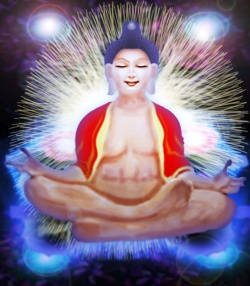Svabhava
Svabhava (Sanskrit: स्वभाव; IAST: svabhāva) Pāli: sabhāva; Chinese: 自性 zìxìng; Tibetan: རང་བཞིན, Wylie: rang-bzhin) literally means "own-being" or "own-becoming". It is the intrinsic nature, essential nature or essence of living beings.
The concept and term svabhāva are frequently encountered in Dharmic traditions such as Advaita Vedānta (e.g. in the Avadhūta Gītā), Mahāyāna Buddhism (e.g. in the Ratnagotravibhāga), Vaishnavism (e.g., the writings of Rāmānuja) and Dzogchen (e.g. in the seventeen tantras).
In the nondual Advaita Vedānta yoga text, Avadhūta Gītā, Brahman (in the Upanishadic denotation) is the sabhāva. In the Pāli tradition of the Buddhadharma: "To become Brahman is to become highest self-nature (sabhāva)" (Atthakanipata-Att. 5.72).
In the Mahāyāna Buddhadharma tradition(s) it is one of a suite of terms employed to denote the Buddha-nature, such as "gotra".
Hinduism
Bhagavad Gītā
The Bhagavad Gītā (18.41) has nature (svabhava) as a distinguishing quality differentiating the varṇā.
Overzee (1992: p. 74) in her work on de Chardin (1881–1955) and Rāmānuja (1017–1137) highlights Rāmānuja's usage of svabhāva in relation to Brahman thus:
- Let us look more closely at what Rāmānuja means by the Lord's "nature". If you read his writings, you will find that he uses two distinct yet related words when referring to the nature of Brahman: svarūpa and svabhāva.
Buddhism
In early Theravādin texts, the term "svabhāva" did not carry the technical meaning or the soteriological weight of later writings. Much of Mahāyāna Buddhism (as in the Prajñāpāramitā Sūtra) denies that such a svabhāva exists within any being; however, in the tathāgatagarbha sutras (notably the Nirvāṇa Sūtra), the Buddha states that the immortal and infinite Buddha-nature - or "true self" of the Buddha - is the indestructible svabhāva of beings.
Theravāda
In the Pāli canon, "sabhāva" is absent from what are generally considered to be the earliest texts. When found in later texts (e.g., the paracanonical Milindapañha), it generically refers to state (of mind), character or truth.
In the post-canonical Abhidhamma literature, sabhāva is used to distinguish an irreducible, dependent, momentary phenomenon (dhamma) from a conventionally constructed object. Thus, a collection of visual and tactile phenomena might be mentally constructed into what is conventionally referred to as a "table"; but, beyond its constituent elements, a construct such as "table" lacks intrinsic existence (sabhāva).
Prajnaparamita Sutras
In the Prajñāpāramitā sutras, the early Buddhist notion of no-self (anatta) is extended to all objects, so that all things are emptiness (śūnyatā), without inherent existence (svabhāva).
Madhyamaka
Robinson (1957: p. 300) in discussing the Buddhist logic of Nāgārjuna, states:
- Svabhāva is by definition the subject of contradictory ascriptions. If it exists, it must belong to an existent entity, which means that it must be conditioned, dependent on other entities, and possessed of causes. But a svabhāva is by definition unconditioned, not dependent on other entities, and not caused. Thus the existence of a svabhāva is impossible.
Dzogchen
Bonpo Dzogchen
Svabhāva is very important in the nontheistic theology of the Bonpo Great Perfection (Dzogchen) tradition where it is part of a technical language to render macrocosm and microcosm into nonduality, as Rossi (1999: p. 58) states:
- The View of the Great Perfection further acknowledges the ontological identity of the macrocosmic and microcosmic realities through the threefold axiom of Condition (ngang), Ultimate Nature (rang bzhin) and Identity (bdag nyid). The Condition (ngang) is the Basis of all (kun gzhi) -- primordially pure (ka dag) and not generated by primary and instrumental causes. It is the origin of all phenomena. The Ultimate Nature (rang bzhin) is said to be unaltered (ma bcos pa), because the Basis [gzhi] is spontaneously accomplished (lhun grub) in terms of its innate potential (rtsal) for manifestation (rol pa). The non-duality between the Ultimate Nature (i.e., the unaltered appearance of all phenomena) and the Condition (i.e., the Basis of all) is called the Identity (bdag nyid). This unicum of primordial purity (ka dag) and spontaneous accomplishment (lhun grub) is the Way of Being (gnas lugs) of the Pure-and-Perfect-Mind [byang chub (kyi) sems].
The Mirror of the Mind of Samantabhadra
The term "svabhāva" is mentioned in six verses of the first chapter of the Avadhūta Gītā: 1.5, 1.6, 1.44, 1.54, 1.58, 1.76.
This extreme nondual yoga text shares a lot of common language with the extreme nondual yoga of Atiyoga (Dzogchen) and its standard Tibetan analogue rang-bzhin (Wylie) is employed in The Mirror of the Mind of Samantabhadra, one of the Seventeen Tantras of Atiyoga Upadesha.
The following quotation from The Mirror of the Mind of Samantabhadra is drawn from the Lungi Terdzö:
You should understand that the nature of all phenomena is that of the five aspects of Samantabhadra.
What are these? you ask
They are Samantabhadra as nature,
Samantabhadra as adornment,
Samantabhadra as teacher,
Samantabhadra as awareness, and
Samantabhadra as realization .
Namkhai Norbu
Dzogchen teacher Namkhai Norbu (2001: p. 155) in discussing the view of the pratyekabuddhas states that:
- ... the Pratyekabuddhas accede to the absence of a self or independent self-nature (bdag med).

